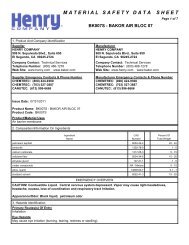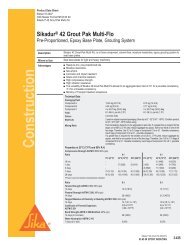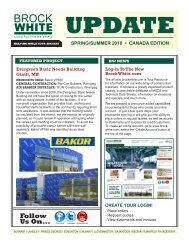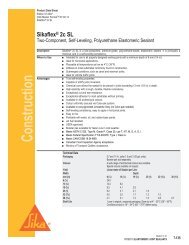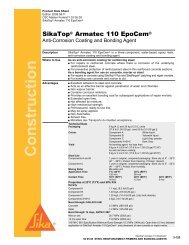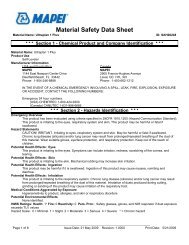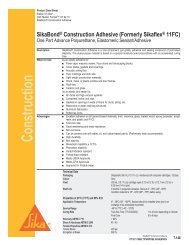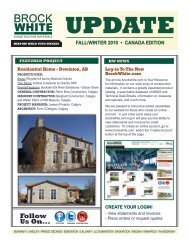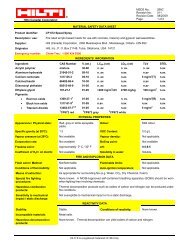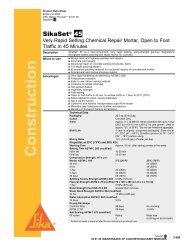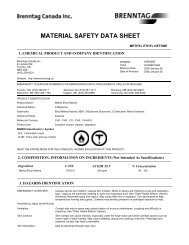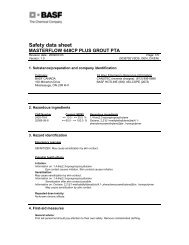Hilti TE 50 Drill Operations Manual
Hilti TE 50 Drill Operations Manual
Hilti TE 50 Drill Operations Manual
You also want an ePaper? Increase the reach of your titles
YUMPU automatically turns print PDFs into web optimized ePapers that Google loves.
<strong>Hilti</strong> Corporation<br />
LI-9494 Schaan<br />
Tel.: +423 / 234 21 11<br />
Fax: +423 / 234 29 65<br />
www.hilti.com<br />
<strong>TE</strong> <strong>50</strong> /<br />
<strong>TE</strong> <strong>50</strong>-AVR<br />
Bedienungsanleitung<br />
Operating instructions<br />
Mode d’emploi<br />
<strong>Manual</strong> de instrucciones<br />
Istruzioni d’uso<br />
Gebruiksaanwijzing<br />
Brugsanvisning<br />
Bruksanvisning<br />
Bruksanvisning<br />
Käyttöohje<br />
<strong>Manual</strong> de instruções<br />
Οδηγιες χρησεως<br />
Lietoßanas pamåcîba<br />
Instrukcija<br />
Kasutusjuhend<br />
de<br />
en<br />
fr<br />
es<br />
it<br />
nl<br />
da<br />
no<br />
sv<br />
fi<br />
pt<br />
el<br />
lv<br />
lt<br />
et<br />
<strong>Hilti</strong> = registered trademark of <strong>Hilti</strong> Corp., Schaan W 3254 0607 00-Pos. 1 1 Printed in Liechtenstein © 2007<br />
Right of technical and programme changes reserved S. E. & O.<br />
383919 / B<br />
*383919*<br />
383919
1<br />
2<br />
4<br />
3<br />
4/6<br />
5 3 2<br />
1<br />
3<br />
2<br />
1<br />
6<br />
1<br />
2<br />
5<br />
5<br />
1<br />
7<br />
3<br />
3<br />
2<br />
7<br />
5<br />
4<br />
D<br />
C<br />
9<br />
B<br />
A<br />
7:30<br />
a.m<br />
4<br />
1<br />
4<br />
5<br />
2<br />
3<br />
6<br />
6<br />
1<br />
2<br />
07<br />
8<br />
7
<strong>TE</strong> <strong>50</strong> / <strong>TE</strong> <strong>50</strong>‐AVR combi hammer<br />
It is essential that the operating instructions<br />
are read before the power tool is operated<br />
for the first time.<br />
Always keep these operating instructions<br />
together with the power tool.<br />
Ensure that the operating instructions are<br />
with the power tool when it is given to other<br />
persons.<br />
Contents<br />
Page<br />
1. General information 17<br />
2. Description 19<br />
3. Insert tools, accessories 21<br />
4. Technical data 21<br />
5. Safety rules 22<br />
6. Before use 25<br />
7. Operation 25<br />
8. Care and maintenance 27<br />
9. Troubleshooting 28<br />
10. Disposal 29<br />
11. Manufacturer’s warranty ‐ tools 30<br />
12. EC declaration of conformity 30<br />
1 These numbers refer to the corresponding illustrations.<br />
The illustrations can be found on the fold‐out<br />
cover pages. Keep these pages open while studying<br />
the operating instructions.<br />
In these operating instructions, the designation “the<br />
power tool” always refers to the <strong>TE</strong> <strong>50</strong> or <strong>TE</strong> <strong>50</strong>‐AVR<br />
combihammer.<br />
Operating controls and indicators 1<br />
@ Chuck<br />
; Function selector switch<br />
= Control switch<br />
% Supply cord<br />
& Side handle<br />
( Depth gauge<br />
) Service indicator<br />
+ Theft protection indicator (option)<br />
§ AVR active vibration reduction (only<br />
<strong>TE</strong> <strong>50</strong>‐AVR)<br />
en<br />
1. General information<br />
1.1 Safety notices and their meaning<br />
WARNING<br />
Draws attention to a potentially dangerous situation<br />
that could lead to serious personal injury or fatality.<br />
1.2 Explanation of the pictograms and other<br />
information<br />
Warning signs<br />
CAUTION<br />
Draws attention to a potentially dangerous situation<br />
that could lead to slight personal injury or damage to<br />
the equipment or other property.<br />
General<br />
warning<br />
Warning:<br />
electricity<br />
Warning: hot<br />
surface<br />
NO<strong>TE</strong><br />
Draws attention to an instruction or other useful<br />
information.<br />
17
en<br />
Obligation signs<br />
Wear eye<br />
protection<br />
Wear a hard<br />
hat<br />
Wear ear<br />
protection<br />
Wear<br />
protective<br />
gloves<br />
Location of identification data on the power tool<br />
The type designation and serial number can be found<br />
on the type identification plate on the machine or tool.<br />
Make a note of this data in your operating instructions<br />
and always refer to it when making an enquiry to your<br />
<strong>Hilti</strong> representative or service department.<br />
Type:<br />
Serial no.:<br />
Wear<br />
breathing<br />
protection<br />
Symbols<br />
Read the<br />
operating<br />
instructions<br />
before use<br />
Return waste<br />
material for<br />
recycling.<br />
<strong>Drill</strong>ing<br />
without<br />
hammering<br />
Hammer<br />
drilling<br />
Chiseling<br />
Chisel position<br />
adjustment<br />
Volts<br />
Amps<br />
Watts<br />
Alternating<br />
current<br />
Hertz<br />
Rated speed<br />
under no load<br />
Revolutions<br />
per minute<br />
Diameter<br />
Double<br />
insulated<br />
Equipped with<br />
theft<br />
protection<br />
system<br />
Lock symbol<br />
18
2. Description<br />
2.1 Use of the product as directed<br />
The power tool is an electrically‐powered combihammer with pneumatic hammering mechanism.<br />
The power tool is intended for drilling in concrete, masonry, metal and wood.<br />
The power tool can also be used for light to medium‐duty chiseling work on masonry and for surface finishing<br />
on concrete.<br />
Working on materials hazardous to the health (e.g. asbestos) is not permissible.<br />
The power tool is designed for professional use and may be operated, serviced and maintained only by trained,<br />
authorized personnel. This personnel must be informed of any special hazards that may be encountered. The<br />
power tool and its ancillary equipment may present hazards when used incorrectly by untrained personnel or<br />
when used not as directed.<br />
The working environment may be as follows: construction site, workshop, renovation, conversion or new<br />
construction.<br />
The power tool may be used only in a dry environment.<br />
Do not use the power tool where there is a risk of fire or explosion.<br />
The power tool may be operated only when connected to a power supply providing a voltage and frequency in<br />
compliance with the information given on its type identification plate.<br />
Modification of the power tool or tampering with its parts is not permissible.<br />
To avoid the risk of injury, use only genuine <strong>Hilti</strong> accessories and insert tools.<br />
Observe the information printed in the operating instructions concerning operation, care and maintenance.<br />
en<br />
2.2 Chuck<br />
<strong>TE</strong>‐Y chuck (SDS‐max)<br />
2.3 Switches<br />
Speed control switch for smooth starting<br />
Function selector switch:<br />
Hammer drilling<br />
<strong>Drill</strong>ing without hammering<br />
Chiseling<br />
Chisel position adjustment (12 positions)<br />
2.4 Grips<br />
Vibration‐absorbing, pivotable side handle<br />
Vibration‐absorbing grip<br />
2.5 Protective device<br />
Mechanical slip clutch<br />
Electronic restart interlock to prevent the power tool starting unintentionally after an interruption in the electric<br />
supply (see section 9 “Troubleshooting”).<br />
2.6 Lubrication<br />
Oil lubrication<br />
2.7 Active vibration reduction (only <strong>TE</strong> <strong>50</strong>‐AVR)<br />
The power tool is equipped with an AVR active vibration reduction system which reduces vibration significantly<br />
compared to power tools without active vibration reduction.<br />
19
2.8 TPS theft protection system (optional)<br />
The power tool may be equipped with the TPS theft protection system as an option. If the power tool is equipped<br />
with this feature, it can be unlocked and made ready for operation only through use of the corresponding TPS<br />
key.<br />
en<br />
2.9 LED indicators<br />
Service indicator LED (see section “Care and maintenance”)<br />
Theft protection system indicator (optional) (see section “Operation”)<br />
2.10 Items supplied as standard<br />
1 Power tool with side handle<br />
1 <strong>Hilti</strong> toolbox<br />
1 Operating instructions<br />
1 Depth gauge<br />
1 Cleaning cloth<br />
1 Grease<br />
1 Dust shield<br />
2.11 Using extension cords<br />
Use only extension cords of a type approved for the application and with conductors of adequate cross section.<br />
The power tool may otherwise loose performance and the extension cord may overheat. Check the extension<br />
cord for damage at regular intervals. Replace damaged extension cords.<br />
Recommended minimum conductor cross section and max. cable lengths<br />
Conductor cross section 1.5 mm² 2mm² 2.5 mm² 3.5 mm²<br />
Mains voltage 100V 30 m <strong>50</strong> m<br />
Mains voltage 110‐120 V 20 m 30 m 40 m<br />
Mains voltage 220‐240 V 30 m 75 m<br />
Do not use extension cords with 1.25 mm² conductor cross section.<br />
2.12 Using extension cords outdoors<br />
When working outdoors, use only extension cords that are approved and correspondingly marked for this<br />
application.<br />
2.13 Using a generator or transformer<br />
This power tool may be powered by a generator or transformer when the following conditions are fulfilled:<br />
The unit must provide a power output in watts of at least twice the value printed on the type identification<br />
plate on the power tool. The operating voltage must remain within +5% and ‐15% of the rated voltage at all<br />
times, frequency must be in the <strong>50</strong> – 60 Hz range and never above 65 Hz, and the unit must be equipped with<br />
automatic voltage regulation and starting boost.<br />
Never operate other power tools or appliances from the generator or transformer at the same time. Switching<br />
other power tools or appliances on and off may cause undervoltage and / or overvoltage peaks, resulting in<br />
damage to the power tool.<br />
20
3. Insert tools, accessories<br />
TPS theft protection system with company card,<br />
company remote and TPS‐K key<br />
Chuck<br />
Setting tool<br />
Quick‐release chuck<br />
Dust removal system<br />
Hammer drill bits<br />
Breach bits<br />
Percussion core bits<br />
Chisels<br />
Wood drill bits<br />
Metal drill bits<br />
Option<br />
<strong>TE</strong>‐Y<br />
Setting tool with <strong>TE</strong>‐Y connection end<br />
Keyless chuck for wood and metal drill bits with<br />
smooth or hex. shank, Chuck holder<br />
<strong>TE</strong> DRS‐S<br />
Ø 12…32 mm<br />
Ø 30…32 mm<br />
Ø 45…90 mm<br />
Pointed, flat and shaped chisels with <strong>TE</strong>‐Y connection<br />
end<br />
Ø 6…35 mm<br />
Ø 6…13 mm<br />
en<br />
4. Technical data<br />
Right of technical changes reserved.<br />
NO<strong>TE</strong><br />
The power tool is available in various voltage ratings. Please refer to the type identification plate for details of<br />
the power tool’s voltage and power rating.<br />
Power tool<br />
Rated power input<br />
Rated voltage / rated current<br />
Mains frequency<br />
Weight in accordance with EPTA procedure 01/2003,<br />
<strong>TE</strong> <strong>50</strong><br />
Weight in accordance with EPTA procedure 01/2003,<br />
<strong>TE</strong> <strong>50</strong>‐AVR<br />
Dimensions (L x W x H)<br />
Speed under no load<br />
Single impact energy<br />
<strong>Drill</strong>ing dia. range in concrete/masonry (hammer<br />
drilling)<br />
Breach bits<br />
Percussion core bits<br />
<strong>Drill</strong>ing dia. range in wood (solid)<br />
<strong>TE</strong> <strong>50</strong> / <strong>TE</strong> <strong>50</strong>‐AVR<br />
1,0<strong>50</strong> W<br />
Rated voltage 100 V: 12.8 A<br />
Rated voltage 110 V: 12.6 A<br />
Rated voltage 120 V: 12.7 A<br />
Rated voltage 220 V: 5.7 A<br />
Rated voltage 230 V: 5.8 A<br />
Rated voltage 240 V: 5.8 A<br />
<strong>50</strong>…60 Hz<br />
5.7 kg<br />
5.8 kg<br />
462 mm x 113 mm x 243 mm<br />
5<strong>50</strong> r.p.m.<br />
5.2 J<br />
Ø 12…32 mm<br />
Ø 30…32 mm<br />
Ø 45…90 mm<br />
Ø 6…35 mm<br />
21
en<br />
Power tool<br />
<strong>TE</strong> <strong>50</strong> / <strong>TE</strong> <strong>50</strong>‐AVR<br />
<strong>Drill</strong>ing dia. range in metal (solid)<br />
Ø 6…13 mm<br />
Noise and vibration information (measured in accordance with EN 60745 ):<br />
Typical A‐weighted sound power level, <strong>TE</strong> <strong>50</strong>‐AVR 104 dB (A)<br />
Typical A‐weighted sound power level, <strong>TE</strong> <strong>50</strong> 106 dB (A)<br />
Typical A‐weighted emission sound pressure level, 93 dB (A)<br />
<strong>TE</strong> <strong>50</strong>‐AVR<br />
Typical A‐weighted emission sound pressure level, 95 dB (A)<br />
<strong>TE</strong> <strong>50</strong><br />
Uncertainty for the given sound level<br />
3 dB (A)<br />
Triaxial vibration value for the <strong>TE</strong> <strong>50</strong>‐AVR (vibration<br />
vector sum)<br />
Measured in accordance with EN 60745‐2‐1 prAA:<br />
2005<br />
<strong>Drill</strong>ing in metal, (a h, D )<br />
< 2.5 m/s²<br />
Triaxial vibration value for the <strong>TE</strong> <strong>50</strong>‐AVR (vibration<br />
vector sum)<br />
Measured in accordance with EN 60745‐2‐6 prAB:<br />
2005<br />
Hammer drilling in concrete, (a h, HD )<br />
11.4 m/s²<br />
Chiseling, (a h, Cheq<br />
)<br />
8.1 m/s²<br />
Triaxial vibration value for the <strong>TE</strong> <strong>50</strong> (vibration vector<br />
sum)<br />
Measured in accordance with EN 60745‐2‐1 prAA:<br />
2005<br />
<strong>Drill</strong>ing in metal, (a h, D )<br />
< 2.5 m/s²<br />
Triaxial vibration value for the <strong>TE</strong> <strong>50</strong> (vibration vector<br />
sum)<br />
Measured in accordance with EN 60745‐2‐6 prAB:<br />
2005<br />
Hammer drilling in concrete, (a h, HD )<br />
16.1 m/s²<br />
Chiseling, (a h, Cheq )<br />
11.3 m/s²<br />
Uncertainty (K) for triaxial vibration value<br />
1.5 m/s²<br />
Other information about the power tool<br />
Chuck<br />
<strong>TE</strong>‐Y<br />
Protection class as per EN<br />
Protection class II (double insulated) as per<br />
EN 60745<br />
5. Safety rules<br />
5.1 General power tool safety warnings<br />
WARNING! Read all instructions! Failure to follow all<br />
instructions listed below may result in electric shock,<br />
fire and/or serious injury. The term “power tool” in<br />
all of the warnings listed below refers to your mainsoperated<br />
(corded) power tool or battery‐operated<br />
(cordless) power tool. SAVE THESE INSTRUCTIONS.<br />
5.1.1 Work area safety<br />
a) Keep work area clean and well lit. Cluttered or<br />
dark areas invite accidents.<br />
b) Do not operate power tools in explosive atmospheres,<br />
such as in the presence of flammable<br />
liquids, gases or dust. Power tools create sparks<br />
which may ignite the dust or fumes.<br />
c) Keep children and bystanders away while operating<br />
a power tool. Distractions can cause you to<br />
lose control.<br />
5.1.2 Electrical safety<br />
a) Power tool plugs must match the outlet. Never<br />
modify the plug in any way. Do not use any<br />
22
adapter plugs with earthed (grounded) power<br />
tools. Unmodified plugs and matching outlets will<br />
reduce risk of electric shock.<br />
b) Avoid body contact with earthed or grounded<br />
surfaces such as pipes, radiators, ranges and<br />
refrigerators. There is an increased risk of electric<br />
shock if your body is earthed or grounded.<br />
c) Do not expose power tools to rain or wet conditions.<br />
Water entering a power tool will increase<br />
the risk of electric shock.<br />
d) Do not abuse the cord. Never use the cord for<br />
carrying, pulling or unplugging the power tool.<br />
Keep cord away from heat, oil, sharp edges<br />
or moving parts. Damaged or entangled cords<br />
increase the risk of electric shock.<br />
e) When operating a power tool outdoors, use an<br />
extension cord suitable for outdoor use. Use of a<br />
cord suitable for outdoor use reduces the risk of<br />
electric shock.<br />
5.1.3 Personal safety<br />
a) Stay alert, watch what you are doing and use<br />
common sense when operating a power tool. Do<br />
not use a power tool while you are tired or under<br />
the influence of drugs, alcohol or medication. A<br />
moment of inattention while operating power tools<br />
may result in serious personal injury.<br />
b) Use safety equipment. Always wear eye protection.<br />
Safety equipment such as dust mask,<br />
non‐skid safety shoes, hard hat, or hearing protection<br />
used for appropriate conditions will reduce<br />
personal injuries.<br />
c) Avoid accidental starting. Ensure the switch is<br />
in the off‐position before plugging in. Carrying<br />
power tools with your finger on the switch or<br />
plugging in power tools that have the switch on<br />
invites accidents.<br />
d) Remove any adjusting key or wrench before<br />
turning the power tool on. A wrench or a key left<br />
attached to a rotating part of the power tool may<br />
result in personal injury.<br />
e) Do not overreach. Keep proper footing and balance<br />
at all times. This enables better control of<br />
the power tool in unexpected situations.<br />
f) Dress properly. Do not wear loose clothing or<br />
jewellery. Keep your hair, clothing and gloves<br />
away from moving parts. Loose clothes, jewellery<br />
or long hair can be caught in moving parts.<br />
g) If devices are provided for the connection of dust<br />
extraction and collection facilities, ensure these<br />
are connected and properly used. Use of these<br />
devices can reduce dust‐related hazards.<br />
5.1.4 Power tool use and care<br />
a) Do not force the power tool. Use the correct<br />
power tool for your application. The correct power<br />
tool will do the job better and safer at the rate for<br />
which it was designed.<br />
b) Do not use the power tool if the switch does not<br />
turn it on and off. Any power tool that cannot be<br />
controlled with the switch is dangerous and must<br />
be repaired.<br />
c) Disconnect the plug from the power source<br />
and/or the battery pack from the power tool<br />
before making any adjustments, changing accessories,<br />
or storing power tools. Such preventive<br />
safety measures reduce the risk of starting the<br />
power tool accidentally.<br />
d) Store idle power tools out of the reach of children<br />
and do not allow persons unfamiliar with the<br />
power tool or these instructions to operate the<br />
power tool. Power tools are dangerous in the<br />
hands of untrained users.<br />
e) Maintain power tools. Check for misalignment or<br />
binding of moving parts, breakage of parts and<br />
any other condition that may affect the power<br />
tool’s operation. If damaged, have the power<br />
tool repaired before use. Many accidents are<br />
caused by poorly maintained power tools.<br />
f) Keep cutting tools sharp and clean. Properly<br />
maintained cutting tools with sharp cutting edges<br />
are less likely to bind and are easier to control.<br />
g) Use the power tool, accessories and tool bits<br />
etc., in accordance with these instructions and<br />
in the manner intended for the particular type<br />
of power tool, taking into account the working<br />
conditions and the work to be performed. Use of<br />
the power tool for operations different from those<br />
intended could result in a hazardous situation.<br />
5.1.5 Service<br />
a) Have your power tool serviced by a qualified<br />
repair person using only identical replacement<br />
parts. This will ensure that the safety of the power<br />
tool is maintained.<br />
en<br />
23
en<br />
5.2 Additional safety instructions<br />
5.2.1 Personal safety<br />
a) Wear ear protectors. Exposure to noise can cause<br />
hearing loss.<br />
b) Use auxiliary handles supplied with the tool.<br />
Loss of control can cause personal injury.<br />
c) Always hold the power tool securely with both<br />
hands on the grips provided. Keep the grips dry,<br />
clean and free from oil and grease.<br />
d) Breathing protection must be worn if the power<br />
tool is used without a dust removal system for<br />
work that creates dust.<br />
e) Improve the blood circulation in your fingers by<br />
relaxing your hands and exercising your fingers<br />
during breaks between working.<br />
f) Avoid touching rotating parts. Switch the power<br />
tool on only after bringing it into position at<br />
the workpiece. Touching rotating parts, especially<br />
rotating insert tools, may lead to injury.<br />
g) Always lead the supply cord and extension cord<br />
away from the power tool to the rear while<br />
working. This helps to avoid tripping over the cord<br />
while working.<br />
5.2.2 Tool use and care<br />
a) Secure the workpiece. Use clamps or a vice<br />
to secure the workpiece. The workpiece is thus<br />
held more securely than by hand and both hands<br />
remain free to operate the power tool.<br />
b) Check that the insert tools used are compatible<br />
with the chuck system and that they are secured<br />
in the chuck correctly.<br />
c) Switch the power tool off and unplug the supply<br />
cord in the event of a power failure or interruption<br />
in the electric supply. This will prevent accidental<br />
restarting when the electric power returns.<br />
d) Always work from a secure, safe stance.<br />
5.2.3 Electrical safety<br />
b) Check the power tool’s supply cord at regular<br />
intervals and have it replaced by a qualified<br />
specialist if found to be damaged. Check extension<br />
cords at regular intervals and replace<br />
them if found to be damaged. Do not touch the<br />
supply cord or extension cord if it is damaged<br />
while working. Disconnect the supply cord plug<br />
from the power outlet. Damaged supply cords or<br />
extension cords present a risk of electric shock.<br />
c) Dirty or dusty power tools which have been<br />
used frequently for work on conductive materials<br />
should be checked at regular intervals at a<br />
<strong>Hilti</strong> Service Center. Under unfavorable circumstances,<br />
dampness or dust adhering to the surface<br />
of the power tool, especially dust from conductive<br />
materials, may present a risk of electric shock.<br />
d) When working outdoors with an electric tool<br />
or machine, check to ensure that the tool or<br />
machine is connected to the electric supply by<br />
way of a ground fault circuit interrupter (RCD)<br />
with a rating of max. 30 mA (tripping current).<br />
Use of a ground fault circuit interrupter reduces<br />
the risk of electric shock.<br />
e) Use of a ground fault circuit interrupter (RCD<br />
residual current device) with a maximum tripping<br />
current of 30 mA is recommended.<br />
f) In case of an interruption in the electric supply:<br />
Switch the power tool off and unplug the supply<br />
cord. This will prevent accidental restarting when<br />
the electric power returns.<br />
5.2.4 Work area safety<br />
a) Ensure that the workplace is well lit.<br />
b) Ensure that the workplace is well ventilated.<br />
Exposure to dust at a poorly ventilated workplace<br />
may result in damage to the health.<br />
c) If the work involves breaking right through, take<br />
the appropriate safety measures at the opposite<br />
side. Parts breaking away could fall out and / or<br />
fall down and injure other persons.<br />
a) Before beginning work, check the working area<br />
(e.g. using a metal detector) to ensure that no<br />
concealed electric cables or gas and water pipes<br />
are present. External metal parts of the power tool<br />
may become live, for example, when an electric<br />
cable is damaged accidentally. This presents a<br />
serious risk of electric shock.<br />
24
5.2.5 Personal protective equipment<br />
The user and any other persons in the vicinity must<br />
wear suitable eye protection, a hard hat, ear protection,<br />
protective gloves and breathing protection<br />
while the power tool is in use.<br />
en<br />
6. Before use<br />
6.1 Fitting and adjusting the side handle 2<br />
CAUTION<br />
Remove the depth gauge from the side handle in<br />
order to avoid injury.<br />
1. Disconnect the supply cord plug from the power<br />
outlet.<br />
2. Release the side handle clamping band by turning<br />
the handle counterclockwise.<br />
3. Slide the side handle clamping band over the<br />
chuck and onto the cylindrical section at the front<br />
end of the power tool.<br />
4. Pivot the side handle into the desired position.<br />
5. Secure the side handle by turning the grip clockwise.<br />
6.2 Unlocking the power tool<br />
See section “Operation”<br />
6.3 Use of extension cords and generators or<br />
transformers<br />
Please refer to section 2 “Description”.<br />
7. Operation<br />
CAUTION<br />
In accordance with the applications for which it is<br />
designed, the power tool produces a high torque.<br />
Always use the side handle and hold the power<br />
tool with both hands. The user must be prepared for<br />
sudden sticking and stalling of the insert tool.<br />
CAUTION<br />
Use clamps or a vice to hold the workpiece securely.<br />
CAUTION<br />
The collar at the front end of the gearing section is<br />
not to be used as a gripping surface.<br />
7.1 Preparing for use<br />
CAUTION<br />
Wear protective gloves when changing insert tools<br />
as the insert tools get hot during use.<br />
7.1.1 Adjusting the depth gauge 3<br />
1. Release the side handle clamping band by turning<br />
the handle counterclockwise.<br />
2. Pivot the side handle into the desired position.<br />
3. Attach the clamp with the depth gauge to the<br />
clamping band at the desired position.<br />
4. Release the screw at the depth gauge.<br />
5. Adjust the depth gauge to the desired drilling<br />
depth.<br />
6. Tighten the screw at the depth gauge firmly.<br />
25
en<br />
7. Tighten the side handle securely by turning the<br />
grip section. This also clamps the depth gauge in<br />
position.<br />
7.1.2 Fitting the insert tool 4<br />
1. Disconnect the supply cord plug from the power<br />
outlet.<br />
2. Check that the connection end of the insert tool is<br />
clean and lightly greased. Clean it and grease it if<br />
necessary.<br />
3. Check that the sealing lip of the dust shield is<br />
clean and in good condition. Clean the dust shield<br />
if necessary or have it replaced if the sealing lip<br />
is damaged.<br />
4. Push the insert tool into the chuck and rotate it<br />
while applying slight pressure until it engages in<br />
the guide grooves.<br />
5. Push the insert tool further into the chuck until it<br />
is heard to engage.<br />
6. Check that the insert tool has engaged correctly<br />
by pulling it.<br />
7.1.3 Removing the insert tool 5<br />
1. Disconnect the supply cord plug from the power<br />
outlet.<br />
2. Open the chuck by pulling back the insert tool<br />
locking sleeve.<br />
3. Pull the drill bit out of the chuck.<br />
7.2 Operation<br />
CAUTION<br />
Working on the material may cause it to splinter.<br />
Wear eye protection and protective gloves. Wear<br />
breathing protection if no dust removal system is<br />
used. Splintering material presents a risk of injury to<br />
the eyes and body.<br />
CAUTION<br />
The work generates noise. Wear ear protectors.<br />
Exposure to noise can cause hearing loss.<br />
CAUTION<br />
Improve the blood circulation in your fingers by<br />
relaxing your hands and exercising your fingers<br />
during breaks between working.<br />
7.2.1 TPS theft protection system (optional)<br />
NO<strong>TE</strong><br />
The power tool may be equipped with the optional<br />
theft protection system. If the power tool is equipped<br />
with this feature, it can be unlocked and made ready<br />
for operation only through use of the corresponding<br />
TPS key.<br />
7.2.1.1 Unlocking the power tool 6<br />
1. Plug the supply cord into the power outlet. The<br />
yellow theft protection indicator LED blinks. The<br />
power tool is now ready to receive the signal from<br />
the TPS key.<br />
2. Hold the TPS key or the TPS watch strap buckle<br />
against the lock symbol. The power tool is unlocked<br />
as soon as the yellow theft protection<br />
indicator LED no longer lights.<br />
NO<strong>TE</strong> If, for example, the electric supply is briefly<br />
interrupted due to a power failure or disconnected<br />
when moving to a different workplace, the power<br />
tool remains ready for operation for approx. 20<br />
minutes. In the event of a longer interruption, the<br />
TPS key must be used again to unlock the power<br />
tool.<br />
7.2.1.2 Activation of the theft protection system<br />
for the power tool<br />
NO<strong>TE</strong><br />
Further detailed information on activation and use<br />
of the theft protection system can be found in the<br />
operating instructions for the theft protection system.<br />
7.2.2 <strong>Drill</strong>ing without hammering (A) 7<br />
1. Turn the function selector switch until it engages<br />
in the “<strong>Drill</strong>ing without hammering” position. Do<br />
not operate the function selector switch while the<br />
motor is running.<br />
2. Bring the side handle into the desired position<br />
and check that it is fitted correctly and secured.<br />
3. Plug the supply cord into the power outlet.<br />
4. Position the power tool and drill bit at the point<br />
where the hole is to be drilled.<br />
5. Press the control switch slowly (drill at a low<br />
speed until the drill bit centers itself in the hole).<br />
6. Press the control switch fully to continue drilling<br />
with full power.<br />
26
7. Do not apply excessive pressure. This will not<br />
increase the power tool’s drilling performance.<br />
Lower pressure extends the life of the insert tool.<br />
7.2.3 Hammer drilling (B) 7<br />
NO<strong>TE</strong><br />
Working at low temperatures: The hammering mechanism<br />
works only when the power tool has reached<br />
a minimum operating temperature. Bring the tip of<br />
the drill bit or chisel into contact with the workpiece<br />
and allow the power tool to run under no load until<br />
it reaches the minimum operating temperature. If necessary,<br />
repeat this procedure until the hammering<br />
mechanism begins to operate.<br />
1. Turn the function selector switch until it engages<br />
in the “Hammer drilling” position. Do not operate<br />
the function selector switch while the motor is<br />
running.<br />
2. Bring the side handle into the desired position<br />
and check that it is fitted correctly and secured.<br />
3. Plug the supply cord into the power outlet.<br />
4. Position the power tool and drill bit at the point<br />
where the hole is to be drilled.<br />
5. Press the control switch slowly (drill at a low<br />
speed until the drill bit centers itself in the hole).<br />
6. Press the control switch fully to continue drilling<br />
with full power.<br />
7. Do not apply excessive pressure. This will not increase<br />
the power tool’s hammering performance.<br />
Lower pressure extends the life of the insert tool.<br />
8. Reduce drilling speed shortly before breaking<br />
through in order to avoid damage to the surface<br />
at the rear side.<br />
7.2.4 Chiseling<br />
NO<strong>TE</strong><br />
The chisel can be adjusted to 12 different positions<br />
(in 30° increments). This ensures that flat chisels and<br />
shaped chisels can always be set to the optimum<br />
working position.<br />
7.2.4.1 Adjusting the chisel (C) 7<br />
CAUTION<br />
Do not operate the power tool when the selector<br />
switch is set to “Chisel adjustment”.<br />
1. Turn the function selector switch until it engages<br />
in the “Chisel adjustment” position. Do not operate<br />
the function selector switch while the motor<br />
is running.<br />
2. Bring the side handle into the desired position<br />
and check that it is fitted correctly and secured.<br />
3. Rotate the chisel to the desired position.<br />
7.2.4.2 Locking the chisel (D) 7<br />
Turn the function selector switch until it engages in<br />
the “Chiseling” position. Do not operate the function<br />
selector switch while the motor is running.<br />
7.2.4.3 Chiseling(D) 7<br />
1. Plug the supply cord into the power outlet.<br />
2. Position the tip of the chisel at the point where<br />
chiseling is to begin.<br />
3. Press the control switch fully.<br />
en<br />
8. Care and maintenance<br />
CAUTION<br />
Disconnect the supply cord plug from the power<br />
outlet.<br />
8.1 Care of insert tools<br />
Clean off dirt and dust deposits adhering to the insert<br />
tools and protect them from corrosion by wiping the<br />
insert tools from time to time with an oil‐soaked rag.<br />
8.2 Care of the power tool<br />
The outer casing of the power tool is made from<br />
impact‐resistant plastic. Sections of the grip are made<br />
from a synthetic rubber material.<br />
Never operate the power tool when the ventilation<br />
slots are blocked. Clean the ventilation slots carefully<br />
using a dry brush. Do not permit foreign objects to<br />
enter the interior of the power tool. Clean the outside<br />
of the power tool at regular intervals with a slightly<br />
damp cloth. Do not use a spray, steam pressure<br />
cleaning equipment or running water for cleaning.<br />
This may negatively affect the electrical safety of the<br />
power tool. Always keep the grip surfaces of the<br />
power tool free from oil and grease. Do not use<br />
cleaning agents which contain silicone.<br />
27
8.3 Service indicator<br />
NO<strong>TE</strong><br />
The power tool is equipped with a service indicator.<br />
en<br />
Indicator Constant red light End of service interval ‐ servicing is due. After the<br />
lamp lights for the first time, the power tool may<br />
continue to be used for several hours before the<br />
automatic cut‐out is activated. To ensure that the<br />
power tool is always ready for use, it should be<br />
returned to <strong>Hilti</strong> for servicing in good time.<br />
Blinking red light See section “Troubleshooting”.<br />
8.4 Maintenance<br />
WARNING<br />
Repairs to the electrical section of the power tool<br />
may be carried out only by trained electrical specialists.<br />
Check all external parts of the power tool for damage<br />
at regular intervals and check that all controls operate<br />
faultlessly. Do not operate the power tool if parts<br />
are damaged or when the controls do not function<br />
faultlessly. If necessary, the power tool should be<br />
repaired by <strong>Hilti</strong> Service.<br />
8.5 Checking the power tool after care and<br />
maintenance<br />
After carrying out care and maintenance work on<br />
the power tool, check that all protective and safety<br />
devices are fitted and that they function faultlessly.<br />
9. Troubleshooting<br />
Fault Possible cause Remedy<br />
The power tool doesn’t start. Interruption in the electric supply. Plug in another electric appliance<br />
and check whether it works.<br />
The supply cord or plug is defective. Have it checked by a trained<br />
electrical specialist and replaced if<br />
necessary.<br />
Generator with sleep mode. Apply a load to the generator by<br />
connecting another appliance (e.g.<br />
a lamp). Subsequently switch the<br />
power tool off and on again.<br />
Other electrical fault.<br />
Have it checked by a trained<br />
electrical specialist.<br />
The electronic restart interlock is<br />
activated after an interruption in the<br />
Switch the power tool off and on<br />
again.<br />
electric supply.<br />
No hammering action. The power tool is too cold. Allow the power tool to warm<br />
up to the minimum operating<br />
temperature.<br />
See section: 7.2.3 Hammer drilling<br />
(B) 7<br />
The power tool doesn’t start<br />
and the LED blinks red.<br />
A fault has occurred in the power<br />
tool.<br />
If necessary, the power tool should<br />
be repaired by <strong>Hilti</strong> Service.<br />
28
Fault Possible cause Remedy<br />
The power tool doesn’t start<br />
and the LED lights red.<br />
The power tool doesn’t start<br />
and the indicator lamp blinks<br />
yellow.<br />
The power tool doesn’t achieve<br />
full power.<br />
The drill bit doesn’t rotate.<br />
The drill bit / chisel can’t be<br />
released from the chuck.<br />
The carbon brushes are worn.<br />
The power tool has not been<br />
unlocked (power tools with optional<br />
theft protection system).<br />
The extension cord is too long or its<br />
gauge is inadequate.<br />
The voltage provided by the electric<br />
supply is too low.<br />
The function selector switch is not<br />
engaged or is in the “Chiseling” or<br />
“Chisel adjustment” position.<br />
The chuck is not pulled back fully.<br />
The side handle is not fitted<br />
correctly.<br />
Have it checked by a trained<br />
electrical specialist and replaced if<br />
necessary.<br />
Use the TPS key to unlock the power<br />
tool.<br />
Use an extension cord of an<br />
approved length and / or of<br />
adequate gauge.<br />
Connect the power tool to a different<br />
power source.<br />
When the motor has stopped, move<br />
the function control switch to the<br />
“<strong>Drill</strong>ing without hammering” or<br />
“Hammer drilling” position.<br />
Pull the chuck back as far as it will<br />
go and remove the insert tool.<br />
Release the side handle and refit<br />
it correctly so that the clamping<br />
band and side handle engage in the<br />
groove.<br />
en<br />
10. Disposal<br />
Most of the materials from which <strong>Hilti</strong> power tools or appliances are manufactured can be recycled. The<br />
materials must be correctly separated before they can be recycled. In many countries, <strong>Hilti</strong> has already made<br />
arrangements for taking back your old power tools or appliances for recycling. Please ask your <strong>Hilti</strong> customer<br />
service department or <strong>Hilti</strong> representative for further information.<br />
For EC countries only<br />
Disposal of electric tools together with household waste is not permissible.<br />
In observance of European Directive 2002/96/EC on waste electrical and electronic equipment<br />
and its implementation in accordance with national law, electric tools that have reached the end<br />
of their life must be collected separately and returned to an environmentally compatible recycling<br />
facility.<br />
29
en<br />
11. Manufacturer’s warranty ‐ tools<br />
<strong>Hilti</strong> warrants that the tool supplied is free of defects<br />
in material and workmanship. This warranty is valid<br />
so long as the tool is operated and handled correctly,<br />
cleaned and serviced properly and in accordance with<br />
the <strong>Hilti</strong> Operating Instructions, and the technical<br />
system is maintained. This means that only original<br />
<strong>Hilti</strong> consumables, components and spare parts may<br />
be used in the tool.<br />
This warranty provides the free‐of‐charge repair or<br />
replacement of defective parts only over the entire<br />
lifespan of the tool. Parts requiring repair or replacement<br />
as a result of normal wear and tear are not<br />
covered by this warranty.<br />
Additional claims are excluded, unless stringent national<br />
rules prohibit such exclusion. In particular,<br />
<strong>Hilti</strong> is not obligated for direct, indirect, incidental<br />
or consequential damages, losses or expenses in<br />
connection with, or by reason of, the use of, or<br />
inability to use the tool for any purpose. Implied<br />
warranties of merchantability or fitness for a particular<br />
purpose are specifically excluded.<br />
For repair or replacement, send the tool or related<br />
parts immediately upon discovery of the defect to<br />
the address of the local <strong>Hilti</strong> marketing organization<br />
provided.<br />
This constitutes <strong>Hilti</strong>’s entire obligation with regard<br />
to warranty and supersedes all prior or contemporaneous<br />
comments and oral or written agreements<br />
concerning warranties.<br />
12. EC declaration of conformity<br />
Designation:<br />
Combi hammer<br />
Type:<br />
<strong>TE</strong> <strong>50</strong> / <strong>TE</strong> <strong>50</strong>‐AVR<br />
Year of design: 2006<br />
We declare, on our sole responsibility, that<br />
this product complies with the following<br />
directives and standards: 73/23/EEC, 89/336/EEC,<br />
98/37/EC, EN 5<strong>50</strong>14‐1, EN 5<strong>50</strong>14‐2, EN 60745‐1,<br />
EN 60745‐2‐6, EN 61000‐3‐2, EN 61000‐3‐3.<br />
<strong>Hilti</strong> Corporation<br />
Peter Cavada<br />
Matthias Gillner<br />
Head of BU Quality and Process<br />
Executive Vice President<br />
Management<br />
Business Area Electric Tools & Accessories<br />
Business Area Electric<br />
Tools & Accessories<br />
11 2006 11 2006<br />
30



